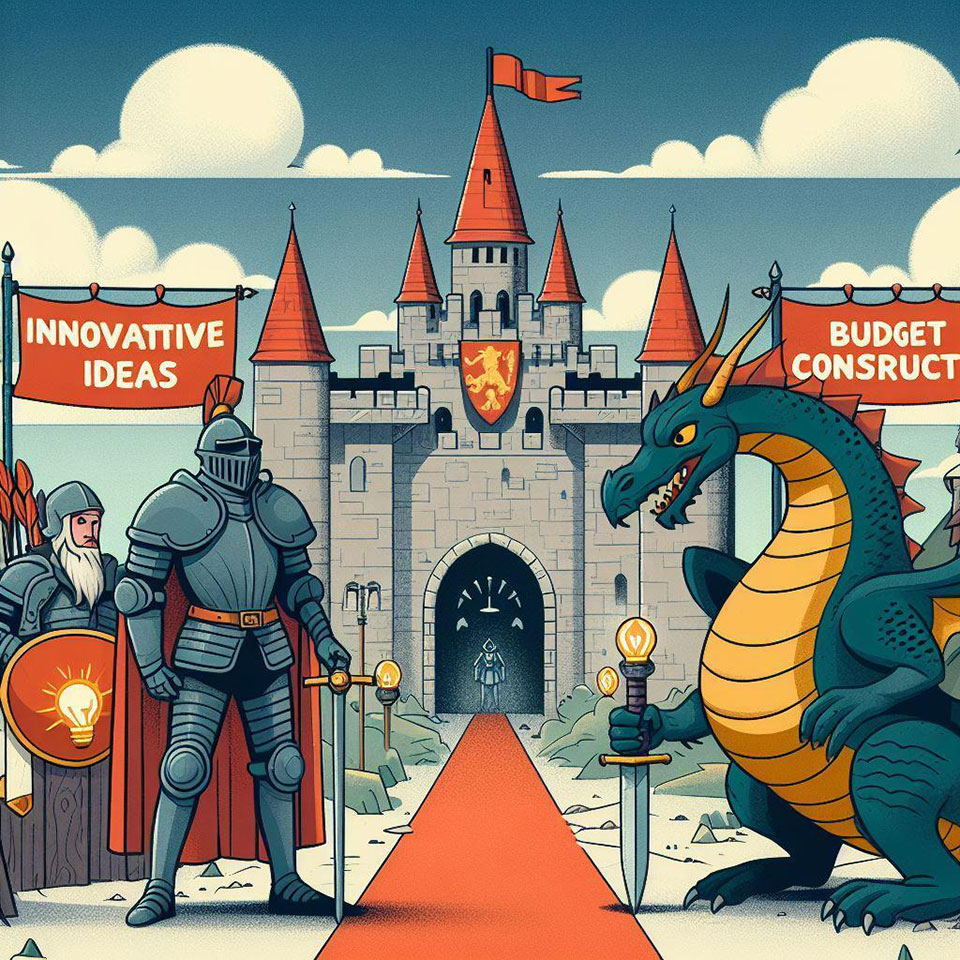Any attempt at cutting costs is welcome in today’s beleaguered marketing departments – but is there room for creativity and AI? In November 2023, ChatGPT reached 100 million users, promising a silver bullet for cash-strapped and time-poor creative teams.
Without the burden of research, time and paying writers, AI-generated content seemed an attractive alternative. But the cracks soon began to show – from “hallucinations” to potential search engine penalisation. Customers soon began to notice generic phrases and a perceived lack of personality in brands’ content.
So how can we overcome this? How can we promote creativity in digital marketing while exploiting the benefits of AI scalability? In this post, we’ll look at AI and human creativity in B2B marketing, focusing on:
- Crafting compelling narratives
- Provoking an emotional response
- Using creativity in PR to enhance storytelling and audience engagement.
The saturated digital landscape
In onebite’s 2024 Marketing Roadmap, we outlined the key focuses for B2B marketing, including the influence of digital campaigns. For instance, three in five decision-makers plan to use these campaigns to increase their brand awareness in 2024.
While this is a worthwhile investment, it is also increasingly competitive. Even before the launch of mainstream models like OpenAI, the internet was saturated with digital media. It’s well-received, with 16 to 64-year-olds spending an average of six hours and 37 minutes per day consuming. But is it still hitting as hard?
Organic reach is in decline
In July 2023, the average engagement rate of an organic Facebook post was in the paltry range of just 1.52 to 2.58%. Add to this a clear preference for search engines to prioritise paid ads, and we have even more competitive bids for attention.
Users are time-poor
Or rather, users’ attention spans are getting shorter. According to informatics professor Dr Gloria Mark, the average screen attention time was 150 seconds in 2004. Today, that’s more like 47 seconds as we look at several screens at once.
Competition is increasing
With fewer barriers to entry, more and more competitors are cropping up across the board. This makes it even more challenging for brands to stand out. In telco, for example, it’s no longer enough to compete on feature sets. We need to create a point of difference through brand-building.
Why creativity counts
There’s a reason why AI and human creativity don’t marry up perfectly. The former may be quick and scalable, but it lacks the depth, nuance and originality of human thought. This comes down to two key factors:
- Large language models are trained on data that already exists. As predictive machines, they generate the most obvious result, which is likely to be clichéd and overused.
- Artificial intelligence does not always understand context. This means it falls down on humour, context and cultural reference. See our example below when we asked AI to create a marketing meme…

So, is there space for generative AI and creativity? Yes, as long as we’re willing to focus on quality rather than quantity. It’s not enough to churn out reams of content day after day with no human-centric angle.
We need to prioritise creativity in marketing, looking at first-person experiences and telling stories to capture emotions.
Creating cut-through
What does this creative content look like? In terms of deliverables, marketers can turn to everything from their customers to earned media opportunities.
User-generated content in B2B
Traditionally associated with B2C, user-generated content (UGC) is gathering pace in the B2B arena. It simply takes a different approach. For instance, we can offer our customers incentives to share their success stories and experiences of working with us.
Incentives could be access to exclusive content or events, or even promoting their business on your platform. The key is to showcase real-life applications of your product through the eyes of your users. You might consider:
- Letting your stakeholders share a behind-the-scenes look at how your product or service works, answering prospects’ questions with real-life context.
- Running interactive forms of UGC including webinars, Q&A sessions or events where customers can discuss their experiences.
- Partnering with well-known thought leaders and influencers. In B2B, customers prefer to hear from experts for harder-to-judge services. But this is no excuse to discount customer reviews, which are ideal for easy-to-judge products and services.
Engagement is as important as distribution
It’s one thing to push out content consistently; it’s another to engage your audience. This is where user interaction comes in – similar to UGC in that it empowers your customers or prospects to get involved.
Think about running quizzes, polls and surveys to invite your users to connect. This offers the perfect first-part data collection opportunity, while simultaneously spreading your brand message to more users.
Thinking of going more technical? Why not try augmented or virtual reality to showcase your product in a real-world scenario? Again, like UGC, this gives your services context and guides potential customers down the funnel.
Remember, your goal is to create an ecosystem based on ongoing interactions, not one-off posts. For more longevity of existing content, try repurposing the assets you have.
You want to trigger an emotional response
Every good marketer wants to trigger emotions. This is why we see so much creativity in PR – and it’s not just limited to B2C, either. A study by the LinkedIn B2B Institute revealed that inspiring emotions in B2B ads is seven times more effective than focusing on the rational benefits alone.
What do we mean by this in practice? Emotions are motivators. While many may tell you that fear is the biggest motivator (see scarcity marketing), we don’t want to elicit negative connotations. Instead, we can focus on emotions that align with our brand values and our audience’s needs – think trust, confidence, excitement, price and belonging.
Think about identifying your customers’ pain points. Are they wasting time or money? Consider their values and their long-term aspirations. And don’t forget that different segments may respond to different emotional triggers – marketing teams might be excited by an analytics dashboard, but finance teams may value confidence in the transparency of your pricing.
You can measure the effectiveness of these methods through engagement. Look for metrics such as repeat visits, longer session durations and average click-through rates.
Keep it simple
William Faulkner once said of Ernest Hemingway that he had “never been known to use a word that might send a reader to the dictionary”. Had Hemingway worked in marketing, he’d have had the right idea. Bombarding our customers with complex jargon will do little more than alienate them – a common problem in the tech and telco space.
With few seconds to capture attention, we need to make our message accessible. This is where a third party, such as an agency, can help. Offering valuable layman insights, they can tell you how your messages are perceived – without the bias of being embedded within the product.
Think about the benefits of your product. Don’t zoom in on the technical specs, but rather the outcomes of the features available. How does this automation save time? Let’s not forget that our customers don’t need all this information at once, either. Prioritise what they need first – saving money, for example – then move on to smaller problems once you’ve sparked their interest.
Your narrative should revolve around the user experience, looking at challenges and solutions. Again, this is where UGC takes the complicated and makes it simple – engaging readers with real-life case studies rather than technical descriptions.
Earned media still offers a big opportunity
Every day, your clients have content coming at them from all directions. This presents an even bigger case for earned media – the assurance that your presence on a trusted platform means you’re a credible brand.
Speak to your agency or marketing team about creative PR campaigns to be featured in your industry’s respected publications. This is why we use the term “earned” – nobody has jumped the queue by paying for an ad, but earned their association with a trustworthy brand.
These associations magnify the impact of your UGC, as well as interactive experiences, emotional storytelling and simple messaging. It’s a crucial opportunity often missed by tech and telco brands – integrating PR with their existing marketing to extend their reach.
Conclusion
The marketer’s battle rages on as they have to compete with more channels, competition and the controversial use of AI. This is where there really is no substitute for human creativity – leaning on experience and emotional intelligence to tell stories.
While there is room for AI, particularly for data analysis, it should serve only to enhance our marketing efforts. It’s up to us as marketers to innovate not only what we create, but how we connect with our audiences. Lived experiences, authenticity and content that triggers emotional responses will truly resonate.
If we use both, paired with an intrinsic understanding of our customers, then we can remain authentic. In turn, we continue to build trust and meaningful relationships while navigating wider challenges.

Jamie MacDow, Head of Client Services
Jamie MacDow, Head of Client Services at onebite, is a strategic and creative problem solver with over 30 years agency-side experience in the marketing and creative industry. During this time, Jamie has won many awards for his client-focussed solutions across the B2Bs, ANAs, UK Content Awards…amongst others.
As well as being a Founding Member of MarketReach by Royal Mail, Jamie has given talks to British Ambassadors, spoken on webinars and podcasts, and created content around our beloved marketing landscape. Somehow, in between all of this, Jamie has also realised a life-long dream and written a fiction novel. Today, Jamie is as focussed on helping brands, big and yet-to-be-big, solve their challenges as he is on agency growth and team happiness.




